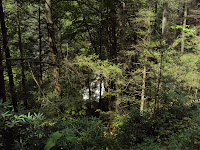No matter which migration route that Alexander West I took, he eventually made it to the land that later became part of Wilkes County. Before coming to that area which eventually became Wilkes, Alexander West I is documented (1752-1755) in tax and census records in Orange County where, at least, two of his children, Alexander II and John, were born. At that time in North Carolina’s history, a section of North Carolina that is today known as Hillsborough in Orange County became the economic and political center of the backcountry.[i] After living in Orange County for an unknown period of time, early records of 1775 document Alexander West I as being in Surry County, from which Wilkes was created in 1777. By 1778, he had arrived in Wilkes County as noted by his documented presence at Glady Branch.

 The former West property lies in this beautiful bottom-land, nestled between these two forested ridges. At the time of our visit, we were not positive that we had located the site where the house had been. This past winter, however, I spoke with a mail carrier who had delivered the mail to the Welborn family, the owners at that time; he had known them very well. Certainly, those Welborn family heirs were from a more recent generation. After I described the site, he confirmed that we had, indeed, found the location where the house had been. The house had burned a number of years ago, but one of the cousins on the trip said that her mother had been there in the 1980s and saw the house before it burned.
The former West property lies in this beautiful bottom-land, nestled between these two forested ridges. At the time of our visit, we were not positive that we had located the site where the house had been. This past winter, however, I spoke with a mail carrier who had delivered the mail to the Welborn family, the owners at that time; he had known them very well. Certainly, those Welborn family heirs were from a more recent generation. After I described the site, he confirmed that we had, indeed, found the location where the house had been. The house had burned a number of years ago, but one of the cousins on the trip said that her mother had been there in the 1980s and saw the house before it burned.Not only is the land picturesque, serene, and pastoral but is noticeably quiet without the noise of vehicular traffic on its winding roads. The mountain ridges on either side of the flat bottom-land provide a presence of security and comfort from the outside world. But, the land is also quite remote. After leaving Highway 421, we wound down and around country roads for some distance before we reached the Stony Fork area. I can just imagine that once winter weather “set in” the local residents were held captive by the distance and the terrain for the duration. Surely, they must have been extremely independent and self-sufficient to have survived. In spite of the hardships that they endured, they were certainly in a setting that could be called “God’s country.”
Thanks to my cousins (FL, CALT, NLS, and AML) for taking my husband and me to Stony Fork. Not only was the weather perfect, but we also enjoyed a great time.
Note: Stony Fork is spelled two ways (Stoney Fork and Stony Fork) in legal documents and on old maps. Also, the spellings for Glady Branch, Glady Fork, and Redy Branch are those used in the legal documents and maps of that period.
[i] Mobley, Joe. A. (ed.). The Way We Lived in North Carolina. Chapel Hill: University of North Carolina Press, 2004.
No comments:
Post a Comment
Thank you for your interest in my blog and for your comment. I have the option of allowing your comments to become public. I will not publish comments with home addresses, phone numbers, or email addresses unless the responder gives permission. I receive notification when someone adds a comment. However, I cannot reply directly to these comments. In order to see my reply, you will need to check the post again.
You may click on photos to enlarge them.